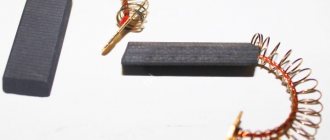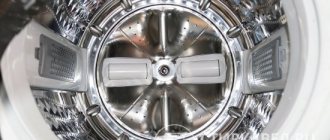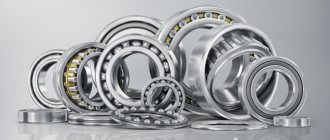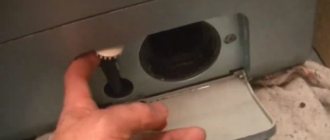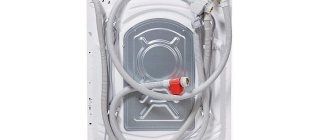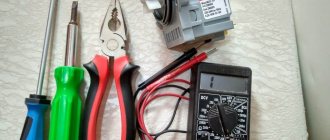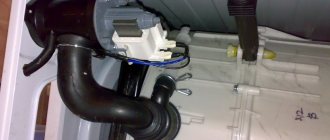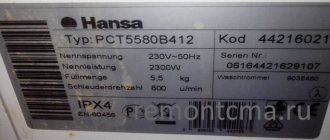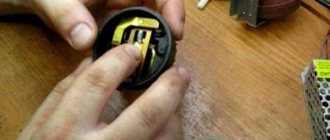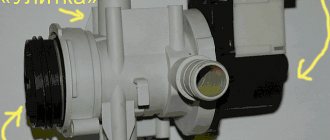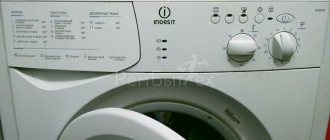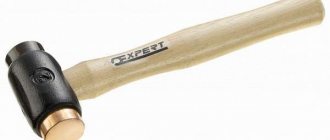For complete independent operation, washing machines are equipped with many components that work interconnectedly. These nodes are controlled by the control unit. This block turns on and off the necessary nodes and controls their operation throughout the entire program.
Components such as the drain pump, solenoid valve and heater have an on and off state, but the engine must develop and maintain different speeds, depending on the program. At the washing stage, it rotates the washing machine drum at a frequency of approximately 50 revolutions per minute, and during the spin cycle it is tens of times faster.
The operation of the engine is controlled by electronics, and a tachometer installed on the engine helps it with this.
The tachogenerator in a washing machine is designed to transmit the existing engine speed to an electronic module, which regulates it and maintains it at the desired speed.
The automatic washing machine engine speed is adjusted by the module by adjusting the current to power the motor.
What is a tachogenerator in a washing machine
The most common tachometer of a washing machine is a coil with a winding, the ends of which are connected to a common block of electric motor power wires. The principle of operation of the tachogenerator is that a magnet rotates inside its coil, which is securely attached to the motor shaft.
At different speeds of rotation of the magnet inside the winding, its resistance changes, which is read by the processor and determines the speed of rotation of the engine and, accordingly, the drum of the washing machine. If the engine rotation speed does not match, the control unit adjusts it to the desired one.
On machines with direct engine drive to the drum, the tachogenerator has a slightly different design, but its operating principle and purpose are the same to regulate engine speed. In such machines, the motor rotates synchronously with the washing machine drum, which makes the rotation speed more precise. This affects the improvement of the quality of washing and the reliability of the entire unit.
Replacing the sensor
If, however, the tachogenerator of your washing machine does not pass the tests, you need to replace it. In this case, it is recommended to dismantle the electric motor of the machine. Let’s say that after diagnosing the tachometer, your machine is disassembled, the electric motor contacts are disconnected, and the drive belt is removed. In this case, what remains is:
- Unscrew the bolts securing the engine and remove it from the machine body.
- Remove the metal or plastic cover of the tachometer. Most often it is on latches.
- Remove the faulty sensor and install a new one.
- Reassemble the washing machine in the reverse order of disassembly.
However, you should remember that if you have never dealt with repairing household appliances, have never held a screwdriver, and the word “multimeter” causes a panic attack, in this case it is better to trust the professionals.
Where is the tachometer located in a washing machine?
The tachogenerator is installed directly on the drive motor. The real part is the coil, mounted on the motor body, and the magnet is fixed on the rotor and rotates synchronously with it inside the sensor coil.
On some models of washing units, speed sensors are additionally installed directly on the tank. One part of the sensor is located permanently on the tank, and the signaling pendulum is located on the rotating pulley of the drum.
Such tachometers are often installed on machines with vertical loading.
Based on its readings, the control module can stop the washing drum in such a position that the loading hatch is at the top of the tank for easy unloading of laundry.
The tachogenerator in direct drive machines is located on the motor stator and reads the speed of the drum pulley, which is part of the engine.
Operating principle
Failure of the electric motor is associated with a current overload in the circuit. This unfavorable phenomenon can be warned by the Hall sensor in the washing machine. Hall sensors are compact and accurate. Sometimes such devices are called rotor rotation control sensors. The sequence of their operation is as follows.
If current flows through a conductor and a magnetic field, the induced magnetic flux can move through the conductor perpendicular to the flow of current, causing charged particles to drift toward the edges of the rectangular strip. These charged particles aggregate at the edges of the surface. The magnetic flux imparts a force to the conductor, causing the voltage (plus sign) to drift toward one edge while the electrons (minus sign) move to the opposite edge. The force acting on the flow of current is called the Lorentz force.
While a magnetic force is applied to a conductor, the carriers are located on opposite sides, creating a voltage drop across the conductor. This voltage drop is the Hall voltage. It is proportional to the current flowing through it, the strength of the magnetic field and the type of conductor material.
If any of these three variables changes, the voltage drop across the conductor will also change. Therefore, the device must have a controlled voltage applied to the current path. If the current is controlled and the conductor material is given, the only thing left to change is the magnetic intensity. The greatest effect will be achieved when it changes at an angle of 90° to the direction of the current.
Signs of a tachometer malfunction
If the sensor is faulty, the control units do not receive engine speed data or receive them in an incorrect form. A breakdown of the tachogenerator of a washing machine entails incorrect operation of the entire device as a whole.
If this part breaks, the machine starts:
- Rotate the drum in the washing mode at the wrong speed. Excessive speeds entail an imbalance of the tank, strong vibration and displacement of the entire product along the base on which it is installed.
- Shock absorbers and bearings are subjected to heavy loads. If the machine has a function for recognizing imbalance, the device stops the programs and displays a fault code on its display;
- When a signal is sent to the electric motor, it begins to quickly gain momentum. At the same time, the machine experiences a beating of the tank inside the body. In belt-driven machines, the belt wears out until it breaks;
- In washing machines equipped with modern inverter engines, an increasing squeak appears, but the drum may not even begin to move.
About the device malfunction
Judging by the reviews of the owners, at the beginning of the program the engine can reach high speeds. This may be caused by a broken winding on the coil or poor fastening. Also, a sharp change in speed indicates that the engine brushes are worn out. It is possible that as a result of vibration, the wiring contacts began to move away. Voltage can be supplied from the control unit to the motor winding, which is why the signal from the tachometer is not received. It happens that the signal stops coming due to the heating of the engine and coil of the device and resumes after they cool down. Due to the instability of the signal, the motor begins to operate in sharp jerks, and may not spin at all. According to experts, in this mode, the engine in a washing machine must provide at least 800 rpm. If the tachometer fails, the number of revolutions is not regulated. Such signs indicate that a chip or crack has formed on the magnetic rotor.
How to check the tachometer on a washing machine
To check the tachogenerator, you must first determine its installation location. After this, you need to remove the wire terminal from the electric motor and find two wires going to the part we need. Using a multimeter set to measure resistance, ring the sensor coil.
The resistance of the washing machine sensor will fluctuate between 70 and 250 ohms, but it may be higher depending on the brand of motor installed on the product. If the multimeter shows any values, then you need to rotate the motor shaft by hand.
In this case, the resistance of a working tachogenerator will change.
If the sensor itself maintains normal resistance values, you need to check the sensor contacts when connected to the engine and control board. It also doesn’t hurt to test the wiring to ensure its integrity.
To do this, you need to switch the tester to the least resistance measurement mode. A common cause of incorrect operation of the tachometer is the loosening of the magnet on the motor shaft. To check, you need to hold the magnet with one hand and try to rotate the shaft with the other. If the magnet rotates on the shaft, it must be securely fastened.
Second way
If you decide to use this method, then the electronic device must be in AC voltage mode. After connecting the probes, start rotating the rotor. In this case, you will see voltage generation, which can vary between 0.5-2 Volts. If so, then there is nothing wrong with your tachogenerator. According to experts, the alternating voltage of the engine in real mode at maximum speed is from 60 to 70 Volts.
How to regulate the engine speed of a washing machine
To regulate the speed in the washing machine, a complex control system is used. It must maintain the speed of the drum with great accuracy under any weight load.
The owner of the machine can only set the speed control of the washing machine drum to spin mode.
But many washing machines have self-diagnosis modes in which you can check whether the set speed is correct. In the LG washing machine, the tachometer in the diagnostic mode shows the rotation speed in the washing mode, the average and maximum engine speed.
Where should I start? First way
First, get a multimeter with an electronic needle or display. Before starting the procedure, disconnect the washing machine from the power supply, water supply and sewerage system. To check the tachogenerator, you do not have to remove it from the engine, but the engine itself will have to be removed from the washing machine. How to check the tachometer on a washing machine with a multimeter? To do this, do the following. First, remove the belt from the shaft. Next, start unscrewing the bolts that secure the motor to the machine. Once the bolts are removed, you can take the engine out. Do not forget to also disconnect all tachogenerator wires from the connector.
Do we test and change the part?
After the part is dismantled, you need to carefully inspect it and the wiring. If you see that any fastening is not held securely, it must be tightened immediately. All latches and contacts must be intact. What to do if no obvious damage is found? Then you need to test the tachogenerator. There are two ways to do this.
First way:
- take a multimeter and set it to measure ohms;
- attach the probes to the tachogenerator contacts;
- Normally, the sensor resistance should be 60 ohms.
Second way:
- set the multimeter to measure volts;
- connect the probes to the contacts;
- with your second hand, accelerate the engine;
- if the number 0.2 appears on the display, it means the sensor is ok.
Replacing a damaged part is easy. To do this, completely remove the wiring and the element cover, which is secured with a regular latch. Unscrew the fasteners, remove the old tachogenerator and install a new one in its place.
In a machine with a commutator motor
It is not difficult to understand what type of motor is installed in your washing machine. If, when removing the rear wall of the unit body, you see a friction wheel (pulley) on which the drive belt is tensioned, then the machine is equipped with a commutator motor. If, when examining the back of the device, you do not find either a pulley or a drive belt, it means that your automatic machine has an inverter motor. Owners of a washing machine with a commutator motor need to look for a Hall sensor directly on the motor shaft.
The tachometer is located either directly on the shaft or very close to it. Its location will depend on the model of the washing machine, the type of sensor and the design as a whole. Carefully inspect the shaft and areas around it. The connection of wires supplying it is certainly directed to the element. Thanks to the cables connected to the tachogenerator via a chip, you can accurately identify the part you are looking for.
Where to look for the part?
Before proceeding directly to checking the sensor, you need to find it. This is not difficult to do, because on all models and brands of washing machines it is located in the same place - on the rotating motor shaft. To get to the latter, you will have to partially disassemble the machine: remove the back panel of the machine body and remove the drive belt.
Before any manipulation, turn off the power to the machine and turn off the water supply tap.
Next is the engine's turn. We are looking for a small iron ring on the shaft - this is the tachogenerator. You can’t unhook it right away; you need to remove the entire motor. Electrical installation experience is important here: if you don’t have it, it’s better to entrust service work to a qualified specialist. You should not experiment with the “stuffing” of the washing machine - there is a high probability of aggravating the situation and bringing the unit to the point of no return or expensive repairs.
